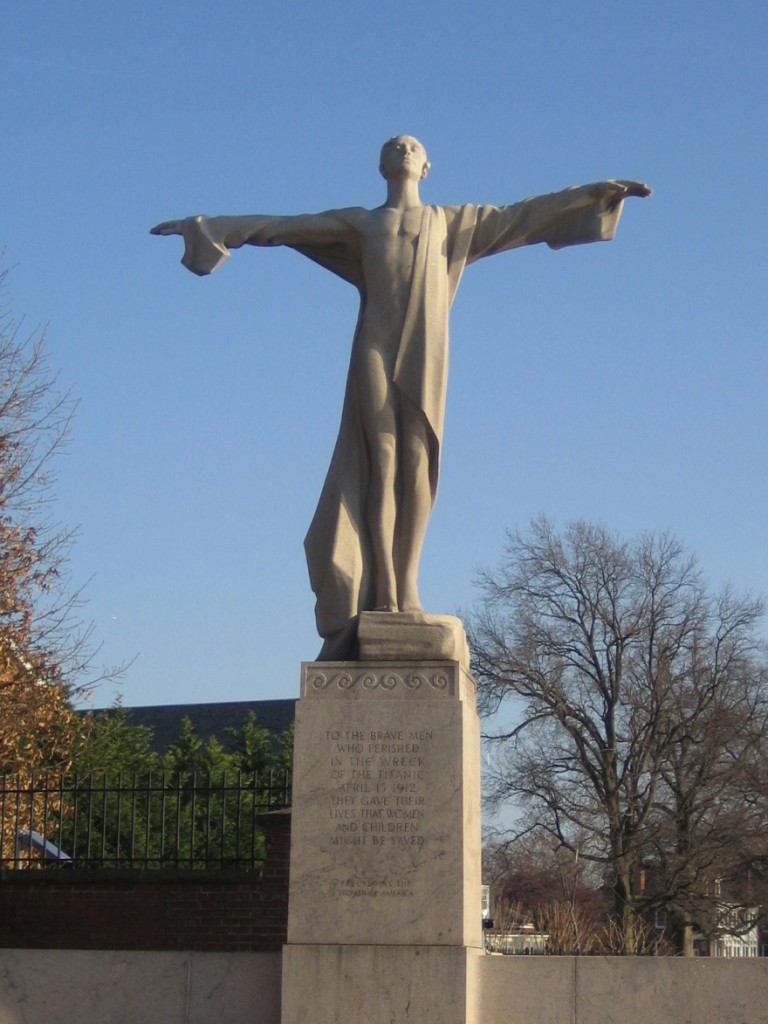On April 14, 1912, the R.M.S. Titanic struck an iceberg off the coast of Newfoundland during its maiden voyage from Southampton to New York. It was considered the greatest technological achievement of its time, but in less than 3 hours, Titanic sank to the bottom of the Atlantic, and 1,517 lives were lost.
On April 14, 2012, it will have been one hundred years since the sinking of the Titanic, and yet we remain captivated by its tragic story and the tales of heroism that have been handed down through generations. Forever etched into our collective consciousness are the stories of men who stood aside so that women and children could be saved; of a father who selflessly put his two young sons in a lifeboat, knowing he would never see them again; of a woman who refused to leave her husbands side, even though it meant certain death; of the brave musicians who kept playing till the very end to comfort those who stayed behind on the doomed ship.
Southwest DC may be thousands of miles away from the site of the Titanic tragedy, but we have a special connection to the Titanic. The Titanic Memorial is a unique feature of our Waterfront that is well-known and loved by many Southwesters. Tucked away in a quiet corner of Waterfront Park next to Fort McNair, this memorial is dedicated to the men who gave their lives during the sinking of the Titanic so that women and children might be saved.
I first encountered the Woman’s Titanic Memorial (its original name) from the Washington Channel as a sailing instructor. From this vantage point, the memorial appears nothing less than the crucifixion of Christ. This misapprehension in this led to sailing instructions that went something like “Take us down south of Jesus and come about.” As it turns out, the memorial is about self-sacrifice, albeit patriarchal stereotypes regarding the role of men and women in the early twentieth century.
Considering its designer Gertrude Vanderbilt Whitney was anything but conventional, one biographer described her as “existing in two worlds. In one, she was the perfect, icy formal uptown matron … in [the] other she was a passionate bohemian who took lover after lover; a lady bountiful to impoverished American artists with who she shared a riotous life in Greenwich Village,” it is difficult to reconcile her life as an artist with the art she produced.
In addition to being an heiress to the New York Railroad and Standard Oil fortunes, Whitney, had a fair bit of maritime history in her family. Her great grandfather was Commodore Cornelius Vanderbilt, and her father-in-law, Secretary of the Navy William C. Whitney. More to the point, she had experienced the direct effects of maritime disaster as her own brother, Alfred Vanderbilt, would perish in the sinking of the Lusitania the same year she began bronze studies for the Woman’s Titanic Memorial. Several critics have noted a striking resemblance between the memorial’s features and her brother’s.
After the sinking of the Titanic in 1912, an organization which went by the same name as the memorial was formed in Washington and, by July, occupied multiple offices collecting donations from across the country for construction of a memorial, as the New York Times described, to commemorate “woman’s tribute to the chivalry and bravery of man as exemplified in the Titanic disaster.” Within two years, the organization had raised $43,000 towards the $50,000 commission for the winning design.
On January 14, 1914, the Washington Fine Arts Commission selected Whitney’s design which, according to the Commission, “showed the figure of Heroism, a man of noble proportions, fifteen feet high, the face, arms, and whole posture of the body exemplifying a willing sacrifice, a smiling welcome to death,” over seven other “sculptors of prominence.”
Whitney began bronze studies for the final work in 1915. One of these has survived in Collington, Maryland at the Holy Trinity Cemetery affixed to the gravesite of a Whitney relative. This early study, signed and dated by Whitney, differs from the Woman’s Titanic Memorial in that the male figure is completely nude with drapery flowing over his shoulder.
The final work, which is considered Whitney’s greatest achievement in sculpture, was unveiled by President Taft’s widow on May 26, 1931, along Rock Creek Parkway near New Hampshire Avenue. The 18-foot figure was actually sculpted by John Horrigan from a single block of red granite in Quincy, Massachusetts. The entire work, including its 6-foot pedestal and 30-foot long exedra designed by the architect of the Lincoln Memorial, Henry Bacon, was completed in 1930.
In 1966, the Memorial was removed and stored at Ft. Washington, Maryland during the construction of the John F. Kennedy Center for the Performing Arts. It was re-erected in 1968 without ceremony on the Washington Channel.
Those responsible for its current site selection could hardly have picked a more inauspicious location. Leaving aside whether Whitney or the memorial merit inclusion in the pantheon of American art, the memorial remains relevant, not as an homage to chivalry as the Committee intended but, far more darkly, industrializations gift to modernity—spectacular carnage on an unprecedented scale. This is, after all, the very essence of the fascination with the Titanic and is equally apropos for what would establish itself as the most violent century in history.


